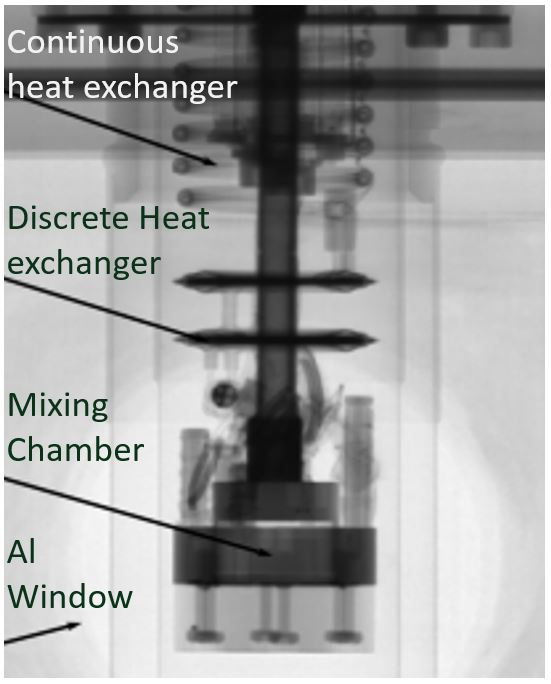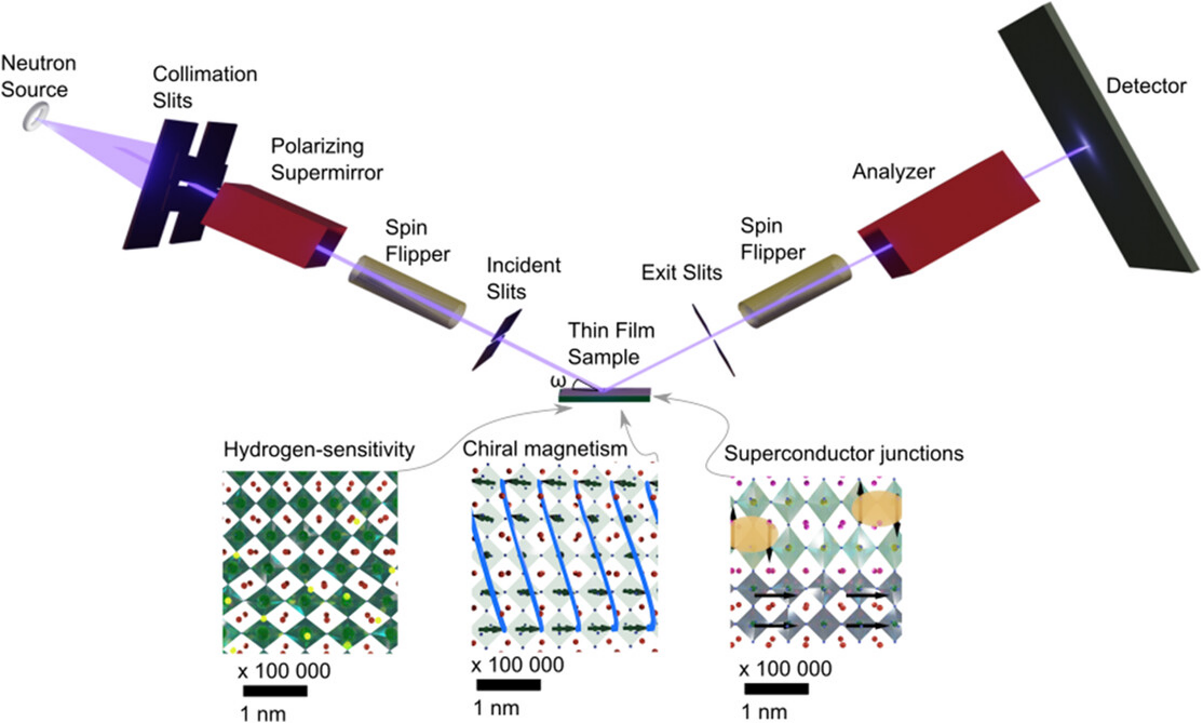
David Cortie, FLEET Scientific Associate Investigator, ANSTO/UOW

Kirrily Rule, FLEET Partner Investigator, ANSTO
The Challenge

Neutrons beams penetrate far into bulk matter, including metals, at normal incidence. This allows neutrons to image systems in a range of operating conditions. Shown: Neutron radiograph of a dilution refrigerator in-operando [REF]
The ability to “see inside” components is key to controlling the relationship between structure and function. This relationship spans many different spatial scales, from the atomic-scale (Å) through to macroscopic engineering scale (cm).
The Solution
Neutrons can selectively penetrate matter to study bulk materials, nanoparticles and nanoscale thin films. Using advanced scattering and spectroscopic techniques, the neutron becomes a quantum sensor that can detect temperature, magnetic fields and electric fields whilst undergoing wave mechanic effects such as diffraction/reflection which provide atomic-scale insights into a material’s structure. For example, coherent specular reflection of neutrons allows for the study of nanoscale thin films and junctions (1-100 nm) with high spatial resolution in the vertical direction.
Key Benefits
- Ability to study films in extreme environments (cryogenics, high temperature, hydrogen-gas)
- Polarised neutron reflectometry fully-implemented for superconducting/magnetic thin films [REF]
- Two 50 mK dilution refrigerators available on diffraction instruments: e.g. Triton (Oxford Inst.)
- High temperature vacuum furnace available ( 1900 K, 1 x10-7 mbar)
- Neutrons available “free-of-charge” via a merit-access scheme for academic research
- Paid access for commercial research also supported (typically $200-$400 per hour). (see online).
Development Stage
17 neutron instruments and 2 hard X-ray instruments are currently operational at the Australian Centre for Neutron Scattering. These are accessed by 500+ users annually and produce 100+ publications per year. Polarised neutron reflectometry, with full polarisation analysis, is now a mature technique, offered to external users since 2012 [REF]. Polarised diffraction, spectroscopy and small angle scattering is also available. Cold polarised neutron imaging is possible.
Brief Description & Differentiation

Neutron beams also reflect strongly from mirror-like objects, at shallow incident angles. This enables an advanced technique, known as polarised neutron reflectometry, for quantum-beam based sensing of structure, magnetism and superconductivity in thin films.
The Australian Centre for Neutron Scattering at ANSTO provides Australian entities with a unique set of world-class capabilities which can be leveraged for competitive advantage. FLEET researchers have made extensive use of the Australian Centre for Neutron Scattering, are available to consult on potential projects. There are also two FLEET investigators (Rule and Cortie) co-located within Australian Centre for Neutron Scattering at ANSTO available to assist.
Intellectual Property
The commercial access scheme allows industry to retain full control over the IP of any work performed at ANSTO. For academic ‘merit’ access, shared IP schemes are available.
Key Publications
- Cortie et al. Physical Review B 86 (5), 054408 (2012)
- Granville, Physical Review B 107 (9), 094408 (2023)
- Bake, Nature Communications 14 (1), 1693 (2023)
- Lawson et al. Scientific Reports 12, 1130 (2022)
More information
- For neutron reflectometry of thin films/superconductors, Dr David Cortie, FLEET/ANSTO dcr@ansto.gov.au
- For neutron diffraction/spectroscopy, Dr Kirrily Rule, FLEET/ANSTO kirrily@ansto.gov.au
- For neutron imaging and small angle scattering: Dr Jamie Schulz jys@ansto.gov.au
- For general questions related to ANSTO industrial engagement and other instrumentation: NISE@ansto.gov.au
- Industry Access – Lucas Heights
